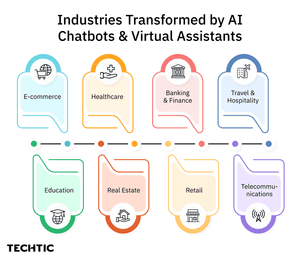Enhancing User Experience with AI: The Role of Chatbots, Virtual Assistants, and Beyond
Sector: UI/UX
Author: Nisarg Mehta
Date Published: 11/07/2024

Contents
Today, customer experience is being remodeled through the centralization of AI for fast, efficient, and personalized interactions. It is demonstrated that the global chatbot market is expected to grow at a Compound Annual Growth Rate (CAGR) of 23.3%, reaching $27,297.2 million by 2030. What’s more interesting is that about 82 % of people don’t mind contacting chatbots over having to wait for a human representative.
Digital interactions of today need to be quick, accurate, and easy, exactly what Artificial Intelligence can perform. AI chatbots and virtual assistants help businesses manage a high volume of inquiries and provide 24*7 support to do so and enhance user satisfaction and loyalty. Automating routine tasks saves time for both users and businesses, making them all work more effectively.
Chatbots: The Foundation of AI-powered Customer Service
AI-driven virtual agents deal very efficiently with customer inquiries. They run 24/7 (a bit different from most customer support) and provide almost instant responses, regardless of your time zone. One of the key benefits chatbots can provide is around-the-clock availability to keep serving your global customer base without additional cost.
Chatbots can handle routine tasks, thus drastically reducing waiting time while increasing customer experience. For instance, Solo Brands deployed a generative AI chatbot that increased the resolution rate for customer interactions from 40% to 75%, resulting in increased customer satisfaction, and decreased escalation needs.
Chatbots can answer questions, sure, but they also help businesses reduce costs by not having to employ vast customer support teams. Companies can also opt to use chatbots to worry about high volumes of inquiries rather than employing many agents at a go, making consumer service more economical.
Furthermore, these AI tools are consistent in responding to all interactions and therefore strengthen brand trust. By following a set of scripts and guidelines, users expect a uniform experience each time they use them, thereby, strengthening brand credibility and customer satisfaction.
Virtual Assistants: Improved Personalization and Engaging Customers
Virtual assistants extend the possibilities of what AI can do by being able to provide personalized and context-aware responses for each user. While chatbots can’t leverage such things as previous interactions or preferences on the user’s side, virtual assistants can easily do this, instantly recommending what feels relevant and personal. Furthermore, it’s this personalized touch that not only engages users but, over time, develops higher customer loyalty too.
Virtual assistants shine in that they can do more than provide basic customer support. When given proper context, they can lead users through more involved tasks — like account setup, managing subscriptions, or product choice. In fields such as retail, for example, where virtual assistants can recommend products based on browsing and buying history, this is big.
Just like chatbots, virtual assistants also handle a higher volume of questions, only with additional functions. They enhance customer satisfaction with customized responses and solutions that can bring back customers and grow conversions. Given this blend of efficiency and personalization, virtual assistants are very valuable tools for businesses trying to provide excellent customer experiences.
Examples Across Industries
Here are some real-world use cases of chatbots and virtual assistants in different industries:

1. E-commerce
AI chatbots are changing the customer shopping experience in the e-commerce industry with AI driven personalized product recommendations based on customers browsing history and preferences. For example, if a customer is always checking for a category of products, the chatbot can suggest some other similar products to make them buy something. Also, chatbots simplify the checkout process and answer the customer’s questions concerning product availability and real‑time shipping and delivery.
2. Healthcare
AI chatbots in healthcare allow patients to schedule appointments, get health information and can help guide patients through their symptom checks. Given that these chatbots are specifically helpful for dealing with frequent questions, like office items or patient capacity, they decrease the workload of medical staff. AI is used by some healthcare providers to remind patients of upcoming appointments or to assist a patient in finding the appropriate specialist, all leading to a more smooth operation and increased patient satisfaction.
3. Banking and Finance
AI chatbots in the banking and finance sector offer 24/7 service support for checking your account balance, seeing your recent transactions, and guiding users on loan or credit applications. But these chatbots can also provide financial advice based on a user’s spending habits and account details. With chatbots, customers can automate routine tasks, receive immediate responses, and enjoy the benefits of greater convenience in banking — the unattended human agents can then put their time and effort towards answering the more complicated questions related to finance.
4. Travel and Hospitality
In the travel and hospitality industry, AI chatbots will help consumers book flights, hotel rooms, and rent cars, also making personalized recommendations according to history and predetermined preferences. These chatbots can answer questions about things like booking changes, cancellations, and available amenities — making travel planning just a bit click-chatter easier. In fact, some even include destination tips or suggestions for itineraries to improve upon the customer’s journey from planning to travel.
5. Education
In education, AI chatbots help students and faculty, by answering common questions, guiding new students through the enrollment process, and helping with course selection. They give instant feedback about deadlines, tuition payments, and campus facilities. Chatbots are being used by some institutions to provide academic support such as offering students a way to help find study resources or quizzes to practice.
6. Real Estate
In the real estate domain, AI chatbots help prospective buyers or renters with property searches, scheduling visits, and giving them neighborhood or amenities information. Chatbots can respond to questions on property detail, pricing, as well as availability which saves clients time, as they make informed decisions faster. In addition to saving real estate agents time by pre qualifying leads and pre-filling data points before a human agent ever steps in, chatbots also increase the efficiency of agents on phone calls and lead to higher close rates.
7. Retail
For example, In the retail industry, AI chatbots can help interact with customers by helping them with product searches, recommendations of products based on past purchases, answering any questions related to store policy or return procedure, or anything else that a firm deals with regularly. Also, customers know that they can get any last-minute questions answered and it streamlines the checkout process guiding customers through online purchases. Such a high level of support improves the shopping experience and consequently augments conversion rate and customer satisfaction.
8. Telecommunications
Telecommunications is among the many industries that rely on AI chatbots for handling a large volume of customer service requests including bill inquiries, upgrading of services, and solving common problems. Customers can view their account status at any time, get a full rundown of their data usage, and adjust their data plans—none of that requires customer service. These chatbots improve the support process by reducing the wait time and improving customer satisfaction through instant and accurate information.
The Impact of AI on User Experience: How to Measure It
Key performance metrics of AI chatbots and virtual assistants are often estimated to represent the effect on user experience. The resolution rate is one of the key metrics; for example, Solo Brands raised resolution rates from 40% to 75% when implementing the generative AI chatbot, and well-designed AI can boost customer happiness and call for fewer escalations.
Customer satisfaction scores also are a direct measure of chatbot success. With regular feedback from users, businesses can see where there is room for improvement allowing chatbots to tackle customer needs and keep the experience positive. Since 60% of business owners believe AI chatbots improve customer experience, naturally, it is essential for companies that use AI in customer support to understand and encourage chatbot adoption.
Moreover, 82% of respondents said they’d rather talk to a chatbot than wait for a human representative, which indicates that chatbots are certainly filling a demand for speed and efficiency. By validating how the chatbot is being used to improve customer service, these metrics also provide direction for more advancements in its development for AI to fulfill evolving customer expectations.
Beyond Chatbots and Virtual Assistants: Future of AI in Customer Experience
The use of AI to enhance customer experience is undergoing rapid progress beyond these basic chatbots and virtual assistants to become more complex and predictive. This is why these modern AI systems take in huge amounts of data and can predict customer needs so that a business can proactively respond or make suggestions they know a customer might want.
One big trend is the move to omnichannel customer experience, where AI systems act over a full stack of customer dimensions: mobile apps, websites, social media, and so forth. By taking this approach, businesses can meet their customers in their preferred channels so they can deliver a seamless, consistent experience wherever the engagement happens.
With predictive AI models, companies not only optimize an operation based on its patterns (which it already does well) but can also build on top of this and identify patterns in customer behavior to make more tactical decisions in improving operational efficiency. These AI tools reduce repetitive tasks and automated responses, which allow human agents to deal with more complex inquiries, meaning a faster response time and lower OPEX.
The more advanced these models become, the more likely businesses that adopt such advanced models in their customer experience initiatives will see a rise in customer satisfaction, loyalty, and growth.



